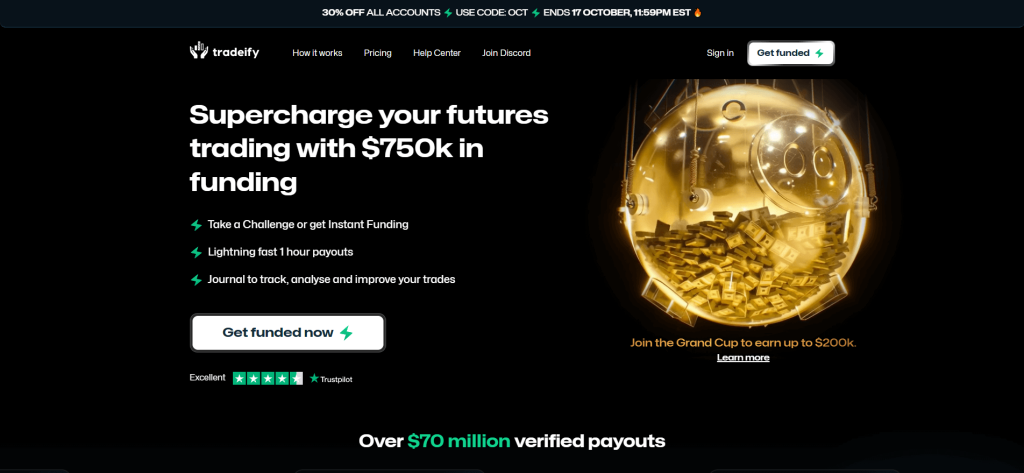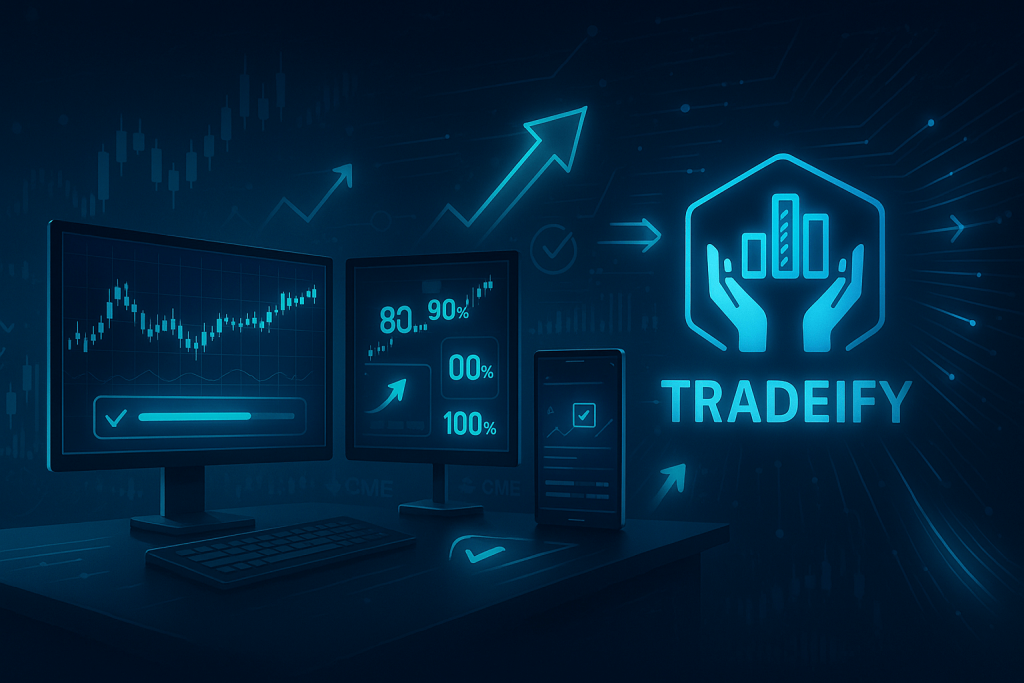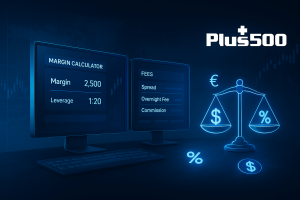Introduction
Founded in the modern era of proprietary trading, Tradeify has positioned itself as a futures‑focused prop firm that emphasizes transparency, accessible capital, and trader‑friendly terms. Unlike older firms that built their reputation over decades, Tradeify emerged as part of the newer generation of firms catering to ambitious futures traders who want significant capital allocations without the lengthy, uncertain evaluation processes of the past. The overall vision: give skilled traders access to meaningful capital while enforcing clear risk rules, and in return reward those who perform with strong profit splits and fast payouts.
Tradeify offers a blend of paths: from challenge‑based evaluation accounts to “straight to simulated funded” access, and ultimately live funded accounts for top performers. This tiered structure means that traders of various experience levels can find a program matching their style—whether you’re a seasoned day‑trader or someone growing into funded trading. Importantly, many traders comment positively about the firm’s transparency of rules and the speed of payouts, which has helped build its credibility in an industry that often struggles with ambiguity and delays.

In short, if you’re a futures trader looking for a prop firm that offers high capital ceilings (with $50K, $100K, $150K and higher account sizes), relatively clear rules, and good payout infrastructure, Tradeify is very much worth evaluating. That said, the structure still demands discipline, risk management, and understanding of the specific rules (drawdowns, consistency, trading days) that underpin each plan. Below we dive into the detailed features and considerations so you can decide whether Tradeify aligns with your trading style and goals.
Account Types & Challenge Details
Tradeify provides a variety of account paths. Broadly speaking, these include Evaluation/Challenge accounts, Simulated Funded accounts, and direct access “Straight to Funded” (also called Lightning or Sim Funded) accounts. Here is how each path breaks down:
Evaluation / Challenge Accounts (“Advanced” & “Growth”)
- The Advanced challenge: For account sizes such as $50K, $100K, $150K, you typically pay an activation fee (for example ~$125) plus a monthly subscription in some cases, and you must reach a profit target. For example, a $50K Advanced account might require a $3,000 profit target and a trailing max drawdown of $2,000 (intraday mode) in evaluation.
- The Growth challenge: For the same sizes, but the drawdown is computed end‑of‑day (EOD) trailing rather than intraday. For example, the $50K Growth may have a $3,000 profit target, a daily loss limit of $1,250, and an EOD trailing drawdown of $2,000.
- For both challenge types: You must abide by the firm’s risk rules (max contracts/positions, trading days minimums in some cases, consistency rules). After passing the challenge you move into a Simulated Funded account of the same size.
Simulated Funded Accounts
- After passing a challenge account, you enter a Simulated Funded account. Here, you are trading on simulated capital (i.e., risk to the firm) but you now become eligible for real profit withdrawals under the firm’s rules rather than simply “passing the challenge.”
- There is also a Lightning / Straight‑to‑Funded path (sometimes called “Straight to Sim Funded”) where you bypass the challenge stage and pay a one‑off fee to start with a Sim Funded account immediately—no monthly subscription. For instance, 25K, 50K, 100K, 150K account sizes under this path may have one‑time fees like $349, $509 etc.
- Each trader may hold up to five funded accounts simultaneously (combination of Growth, Advanced, Lightning) under their house rule.
Capital offered, account sizes & fees
- Sizes: Common account sizes are $25,000, $50,000, $100,000, and $150,000.
- Fees: For the challenge path: Growth may have no activation fee (but monthly subscription), Advanced has an activation fee (e.g., $125) plus monthly subscription. For Straight to Sim: one‑time fee model (e.g., $349 for $25K, $510 for $150K quoted in 2025).
- Example: Straight to Sim Funded one‑time fees: $25K = ~$349; $50K = ~$509; $100K = ~$629; $150K = ~$729.
Evaluation / Challenge Rules
- Intraday Trailing Drawdown applies to Advanced evaluation: You must monitor drawdown in real time.
- End‑of‑Day (EOD) Trailing Drawdown applies to Growth & Lightning: Drawdown is based on end‑of‑day account balance, but still if at any intraday point your account falls below the drawdown you fail.
- Daily loss limits: Growth plans often have a daily loss cap (e.g., $1,250 for $50K Growth) until certain profit level is reached.
- Consistency rule for payouts: For Sim Funded accounts (after challenge) or Lightning: Advanced/Growth: 35% consistency rule (max one day’s profit can’t be more than 35% of total profits in period). Lightning: 20% for first payout, 25% for second, 30% thereafter.
- Minimum trading days/profitable days: For Sim Funded Advanced/Growth accounts: at least 10 trading days (or 5 profitable days over certain threshold) before payout request.
Profit Splits & Withdrawals
When it comes to profit sharing, payout process and conditions, here’s how Tradeify handles things.
Profit Share Percentages
- On Simulated Funded accounts (both after challenge and Lightning): The typical profit split is 90% to the trader and 10% to Tradeify. (Various sources quote that on some first $15,000 in profits they give 100% then revert to 90% but the formal agreement states 90/10)
- On Live Funded accounts (once transitioned): Starting balance payout (after meeting criteria) uses 90/10 split; then for profits above starting balance new monies are split 80% to the trader, 20% to the firm.
Payout Process & Withdrawal Conditions
- Payout requests can be made once the account meets all criteria: minimum account balance above drawdown threshold plus buffer, consistency rule met, minimum days/trades, etc.
- Payout windows: For many Sim Funded accounts, there are specific withdrawal windows each month (1st‑4th, 11th‑14th, 21st‑24th) when payout requests are processed.
- Minimum payout amounts: e.g., for a $50K account, minimum payout might be $500; for $100K, $1,000; for $150K, $1,500.
- Maximum payout tiers: For example: after the 6th payout, payouts up to $25,000 per account are permitted in Sim Funded stage.
- Live accounts: For amounts above the starting balance, daily payout requests are available, with minimum payout of $250.
Withdrawal Conditions & Transition to Live
- When you pass a number of payouts (for example 4 payouts) or reach a total payout amount (e.g., $80,000), Tradeify may transition you from Sim Funded to Live Funded account. A portion of your Sim Funded balance may carry forward.
- After a payout is approved, you must ensure your account stays above the drawdown floor; if you fall below before the request is processed, the payout can be denied.
- Important: the funds you’re withdrawing are your share of the profits; the underlying trading capital remains the firm’s property (especially in Sim Funded stage) as specified in the Funded Trader Agreement.
Trading Platforms & Instruments
Tradeify supports futures trading and uses recognized futures trading platforms and brokers. Here are key points:
- Platforms: Tradeify supports e.g. NinjaTrader and Tradovate among its supported brokers/platforms. Some sources also mention integration with TradingView and that you can link your Tradeify plan.
- Instruments: The focus is predominantly on futures markets (minis & micros). Example: For a $50K account size, you might be allowed up to 4 minis or 40 micros; for $100K maybe 8 minis, etc.
- Optionality: While futures are prominently referenced, the exact list of permitted instruments/platforms should be checked in your specific plan (since rules on scalping, bots, specific instruments may vary).
- Dashboard & tools: Traders report that the Tradeify dashboard includes built‑in journaling, performance analytics and tracking, which helps manage trades and monitor progress.
Trading Rules & Flexibility
The rules are an essential part of what you must abide by when trading with Tradeify. Some are flexible compared to other firms, others are stricter. Here’s the breakdown:
Key Risk Rules
- Trailing Max Drawdown:
For Advanced accounts: Intraday trailing drawdown — meaning as your intraday balance rises, the drawdown limit rises accordingly; if you drop below it during the day you fail.
For Growth / Lightning accounts: End‑of‑day (EOD) trailing drawdown — the limit adjusts only at day’s end based on balance. But again, if you fall below that at any point you still fail. - Daily Loss Limit (DLL): In some plans (Growth, Lightning) you have a soft daily loss limit which converts into the trailing drawdown after certain profit level is reached. For instance, DLL of $1,250 for $50K account.
- Consistency Rule: To withdraw profits, you can’t have one day’s profit represent more than a defined portion of your total profits (20% or 35%, depending on plan) in the period.
- Minimum Trading Days / Profitable Days: Before you can request payouts, you may need to trade a minimum number of days and have a minimum number of profitable days (e.g., 5 days with profits over certain amount).
- Maximum Position Size / Contracts: For each account size your max contracts/minis/micros are defined (e.g., 4 minis for $50K Growth).
- No time limit: Many evaluation/challenge accounts have no fixed time limit to pass—so you can take your time (though fees may apply monthly).
Flexibility and Trader‑Friendly Aspects
- The EOD drawdown model offers more flexibility for traders who hold trades overnight or wider‑stops, compared to intraday drawdown models. Many traders find this more feasible for breakout or swing strategies.
- Lightning / Straight to Sim accounts allow skipping the evaluation stage, so if you’re confident you can manage risk you can proceed directly to profit‑eligible trading.
- No overly restrictive prohibitions reported on holding trades, trading news events (though you always must manage risk). Some sources note fewer “gotcha” constraints than some firms.
Things to Watch
- Intraday trailing drawdown accounts are stricter and less forgiving of large intra‑day reversals. You must manage risk very tightly in these plans.
- Even EOD drawdown plans allow real‑time failure: if your account balance dips below the threshold during the day you can still fail. Traders must stay aware.
- Consistency rule means one large winning day won’t automatically get you to a payout; you need a sustained pattern of trading performance.
- While flexible in many ways, you still must abide by rules such as maximum contracts, no exploitative strategy, timely trade entries etc. The Funded Trader Agreement highlights that you’re an independent contractor, not owner of the funds, and the firm monitors for non‑compliant behavior.
TradingVPS Integration & Advantage
In the high-speed world of futures and prop trading, execution speed and connection stability can be the difference between a passed evaluation and a blown account. For traders on the Tradeify platform—especially those working through the firm’s precise drawdown rules or aiming for their first payout—a well-optimized TradingVPS (Virtual Private Server) provides a serious performance edge.
Why TradingVPS Enhances Your Tradeify Experience
Tradeify’s challenge and funded stages often demand high-frequency decision-making, particularly on platforms like NinjaTrader or Tradovate. With a robust TradingVPS setup, latency is minimized, order slippage reduced, and trading continuity maintained even if your local device disconnects. This is especially critical when operating near drawdown limits or executing rapid intraday strategies where even milliseconds matter.
Whether you’re scalping micros, trading around news releases, or managing multi-account setups, VPS connectivity ensures that trades are routed without disruption. This consistency supports higher win rates and increased confidence across evaluation phases.
Optimized Infrastructure for Tradeify’s Futures Trading Environment
Our TradingVPS solutions are engineered specifically to match the high demands of futures prop trading. Built on Windows Server 2022 with high-frequency CPUs, NVMe SSDs, and dedicated network channels, they deliver rapid order flow into Tradeify’s supported liquidity pools.
Even more importantly, our servers are strategically located near major financial data centers — including Chicago, New York, London, and Frankfurt — to deliver 0–1 ms latency to most prop firm and broker environments. Whether you’re trading from North America or Europe, you can select the VPS location closest to your preferred platform or server for peak performance.
Plans range from lightweight setups for individual funded accounts to enterprise-grade configurations supporting multiple simultaneous accounts, high-volume EAs, and complex multi-chart platforms.
Always-On Reliability and Compatibility
With a 99.99% uptime guarantee and automatic failover protections, a TradingVPS keeps your session alive, ensuring no missed trades due to power outages or home internet issues. Your trading platform—whether it’s NinjaTrader, Tradovate, or other supported environments—stays connected, synced, and ready to execute.
Tradeify’s platform-agnostic approach means you can deploy your strategies with zero compromise. Whether using manual analysis, multi-screen setups, or EA-driven trades, the VPS ensures consistent execution that complements Tradeify’s real-world funding rules and tight risk metrics.
Key Benefits at a Glance
- Strategic server locations: Chicago, New York, London, Frankfurt
- 0–1 ms latency to Tradeify-supported broker servers
- High-speed order routing and reduced slippage
- 99.99% uptime with failover and DDoS protection
- Dedicated RAM and CPU for reliable trading
- Seamless support for NinjaTrader, Tradovate, and more
- Encrypted access from anywhere in the world
- Ideal for scalping, EAs, and high-frequency futures trading
For serious traders aiming to maximize Tradeify’s payout structure or protect their evaluation progress, a TradingVPS isn’t just a technical upgrade — it’s a strategic necessity. Aligning high-performance infrastructure with Tradeify’s trader-centric ecosystem ensures you’re not only funded — but built to stay funded.
Support & Educational Resources
Tradeify appears to place emphasis not only on funding but also on trader support and resources.
- Customer reviews are positive about the support team: many traders report quick responses via Discord, help with technical or account issues, and general responsiveness.
- Integrated journaling and analytics dashboard: Tradeify’s platform includes performance tracking, trade‑streak analysis, P&L breakdown, etc. This supports trader development, which is an educational value rather than purely funding.
- Coaching: Some users reference coaching sessions (e.g., “Coach Tank”) and tailored 1‑on‑1 support for funded traders.
- Transparent documentation: The Help Center and official Agreement include clear rules on drawdowns, payout conditions, transitions to live accounts, etc. This level of clarity is itself a resource for traders to thoroughly understand the structure.
In sum, Tradeify offers more support and educational tooling than many purely “pass/fail” prop firms. For traders serious about improvement (not just passing a challenge), these resources add value.
Pros & Cons
Here’s a consolidated list of what stand out as strengths and weaknesses.
Pros
- Generous profit split (90% for many Sim Funded plans) which is above many competitors.
- High capital account sizes available ($50K, $100K, $150K and scaling potential).
- Multiple account paths to suit different styles (intraday vs end‑of‑day drawdowns; challenge vs direct).
- Trader‑friendly drawdown models (especially EOD trailing drawdown) offer flexibility.
- Fast payout reputation, positive reviews around support responsiveness.
- Clear, transparent rules and documentation: drawdowns, consistency, payout tiers all published.
- Dashboard and performance tools (journaling, analytics) help traders improve.
- Option to transition to Live Funded account for high‑performing traders.
Cons
- Fees can be higher than some competitors for the challenge paths (monthly subscriptions or activation fees).
- Rules are strict: intra‑day trailing drawdowns in Advanced plans leave little margin for error or large swings.
- Payout windows and tiers mean you may not withdraw as frequently or in large chunks initially; there are minimums and caps.
- While many features are flexible, you still need to master risk‑management and be mindful of the rules (which adds complexity).
- As a relatively newer firm compared to long‑established firms, the track record is shorter—though positive.
- Although “straight to funded” is a benefit, the one‑time fee option may be pricier and calls for immediate performance.
Final Verdict
For traders looking for a prop‑funding firm that blends significant capital access, strong profit‑share, and realistic trader tools, Tradeify represents one of the more compelling options in the 2025 prop‑trading space.
Who should consider Tradeify?
- Day traders or swing traders with experience in the futures markets who are comfortable controlling risk and want access to $50K‑$150K (or more) in capital.
- Traders who value transparency of rules, quick payout infrastructure, and who prefer having tools (journaling, dashboard) to track and improve their performance.
- Those who prefer the flexibility of EOD trailing drawdowns (holding overnight trades, swing setups) or are disciplined enough to manage intra‑day trailing drawdown in the Advanced plan.
- Traders who are ready to trade seriously rather than treat this as a “pass the challenge and forget” path.
Who might want to look elsewhere or approach with caution?
- Beginners in futures trading who may struggle with drawdown controls, contract sizing, and risk management—they might prefer a firm with more educational structure or smaller stakes.
- Traders who expect minimal rules or want to trade highly exotic instruments or strategies that might violate prop‑firm policy (always check the permitted assets and broker).
- Those looking for ultra‑low cost entry might find cheaper challenge paths elsewhere; the value here comes with the trade‑offs of higher capital and stricter rules.
Summary
If you’re equipped with a trading plan, understand risk, and are ready to treat this like a business, Tradeify offers a solid, well‑engineered platform. The profit splits and capital opportunities are excellent, and the support and transparency add real value. On the flip side, you must respect the rules and avoid complacency: falling below drawdown thresholds or neglecting consistency can derail the funded account. For a serious trader seeking access to funded trading and wanting more than a “small size, many resets” model, Tradeify stands out as one of the stronger choices.




